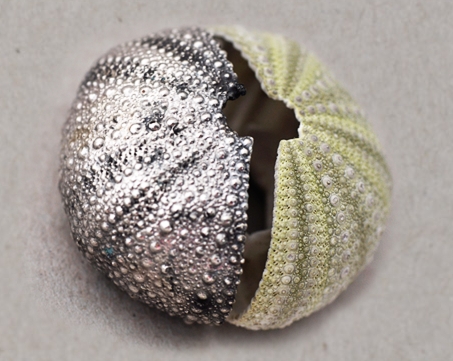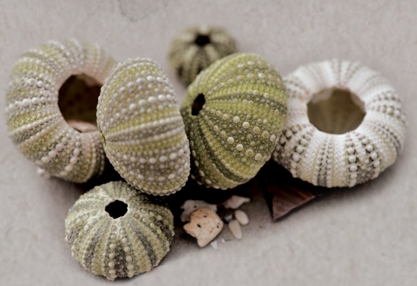

The low down
In case you skipped the first part, here we go again. At the core of the treasure
is pure sea shell. Well, what you and I would think of as a sea shell. However, if
you’re wearing your Biologists’ hat, you would say that sea urchins have ‘tests’
(nothing you could fail) rather than ‘shells’, which, ‘unlike shells, are growing
structures of articulated hard elements’. But we like shells. They’re porous. Five
plates fused together, so impossibly delicate. Fortunately nature by design is far
smarter
than you or I.
When these homeless shells wash up on the Southern tip of Africa they lie camouflaged
on a wild, shell-
Once found (which isn’t as easy as it sounds but we think of it as therapy) the shells go through numerous processes of cleaning and sealing until they are finally plated. It’s not easy for as I told you, the shell is porous. And organic. The porous shell can be unpredictable.
Every care has been taken to dry out the shell and seal it so that no residual moisture
remains.
But we’re clever and so are our chemical engineers who make our plating
tanks resonate with the perfect formula for our needs.
The design
The sea urchin is beautiful by design. Its practical features while alive result
in its beautiful texture when found. We couldn’t do a better job. While alive the
skeleton or shell is covered by long moving spines via a ball and socket arrangement
which form their defence and fend off the nasties that would like to eat them. This
is wild ocean stuff. It’s this ball and socket design that gives your treasure its
texture. The spines fall off and the ‘ball’ remains: the bumps on your urchin. When
we’re lucky we find shells that still have pronounced bumps. In all the tumultuous-
So we extend beauty by our processes. As individual as we are, so is your urchin.
To cater for all of us we’ve set precious or semi-
Warning
There may be traces of nickel as the urchins are plated in an environment where nickel
plating also occurs. These will not be on the final layer of plating, that’s only
the good stuff, gold or silver, but may be underneath these layers. Different perfumes,
individual perspiration – these may have an effect on your urchin, life is a chemical
reaction. If you have trouble wearing silver or gold, if jewellery made from these
metals turns dark and blotchy, chances are it will happen again. That’s your risk,
it’s not our craftsmanship. Clean your treasure regularly, mild dish-
What is inside and out?
At the heart of your treasure is pure seashell:
in the sea urchin world shells are
known as Tests. They’re grown by the critter as a protective outside layer, sort
of like permanent caravanning.
All the Tests have a fivefold symmetry.
Urchins are
part of the Echinodermate family (which means "spiny skin" in Greek) and it’s precisely
this spiny skin that gives our art its art.
We do two metal finishes to our range of sea urchins: silver and gold. However much
you and I think that there should be consistency across computer screens, there isn’t.
We do our best to display the colours beautifully but more importantly, accurately.
But as your screen will differ to ours we can’t guarantee that your screen will be
true to the delivered product.
Each shell has three different layers of metal plating on it, the final being silver or gold in the treasure you’re marvelling at now. So it’s incredibly strong for such a fragile shell. Relatively. You still need to be careful.
We find all our urchins along a stretch of beach near the end of Africa. All of our
work is done locally in South Africa and all of our stones are certified and come
from reputable sources.
As does our metal. We take great care to be as care-
